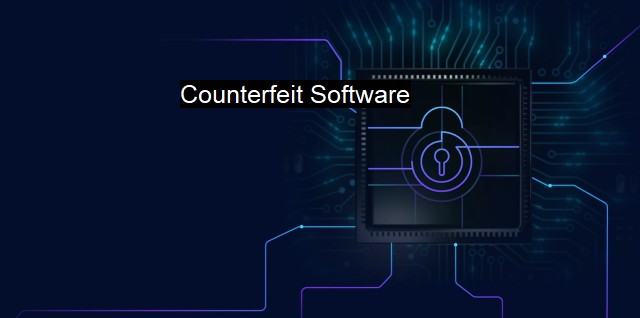What is Counterfeit Software?
The Threat of Counterfeit Software to Cybersecurity: How Illegitimate Programs put Individuals, Businesses, and Governments at Risk
Counterfeit software, often referred to as pirated or cracked software, is an illegal replication or alteration of original and licensed software. The act of using, distributing, or selling counterfeit software comprises software piracy. A counterfeit software is an illegal piece of software that may be indistinguishable from a legitimate product in appearance, though there will usually be noticeable differences in performance, reliability, and security.Counterfeit software has become a significant concern in the global software industry and also for cybersecurity experts for several reasons. It results in financial losses for the developers who invest time and resources into developing these software, but more importantly, for users, counterfeit software poses significant cybersecurity risks.
Counterfeit software usually lacks the security measures and updates that come with legal copies, making them vulnerable to cyber threats. Typically, counterfeit software doesn't receive official updates or patches from the developers. As a result, counterfeit software is often full of bugs and security weaknesses, which can easily be exploited by cybercriminals. Secrets including personal and financial information can then be easily stolen or harmed.
Another severe problem with counterfeit software is the risk of malware and viruses. Cybercriminals often use counterfeit software as bait, embedding hidden viruses, worms, Trojan horses, adware, and other kinds of malicious software into cracked versions of popular software. When users install the counterfeit software, they unknowingly also install malicious software which compromises their system security, damages files, steals sensitive information, or even controls the user’s device.
Counterfeit software, particularly if it's sold on dubious websites, can be associated with malware even if it doesn't have any embedded in it. Cybercriminals can attach malicious codes to the software download button or embed malware into the website where the counterfeit software is hosted or even redirect the user to malicious websites.
Antivirus software plays a crucial role in combating the risks associated with counterfeit software. They help identify and remove malware or potentially unwanted applications often bundled with counterfeit software. it's important to remember that the first line of defense must always be the decision not to engage with counterfeit software. No tools can completely compensate for the risks that come with counterfeit software.
Repercussions of using counterfeit software aren't just limited to cybersecurity threats. Legal implications can be equally damaging. Penalties for using counterfeit software can vary from fines to imprisonment, as is the case with any form of theft or piracy.
Despite the risks associated with counterfeit software, their use is widespread, mainly due to the perceived cost savings. The immediate financial benefits significantly overshadow the potential cybersecurity and legal risks. Users may think they are saving money, but in reality, they’re contributing to an underground economy and exposing themselves to serious cybersecurity threats.
Counterfeit software represents one of the most significant threats primarily due to the double risk it poses. Firstly, by using counterfeit software, individuals and businesses expose themselves to a high risk of cyberattack. Secondly, it undermines the legitimate software industry, causing huge economic losses.
Given the risks and threats involved, consumers and businesses must avoid using counterfeit software. It is vital to procure software legally and ensure that they are continuously updated to fix any vulnerabilities. Security intelligence and threat awareness can go a long way in dissuading users from engaging in the unlawful practice of installing counterfeit software. It is a risky endeavor that goes beyond theft and touches on the critical area of cybersecurity, which impacts not only individuals and businesses but the entire digital ecosystem as well.

Counterfeit Software FAQs
What is counterfeit software?
Counterfeit software refers to software that is illegally copied and sold, often in the form of fake or unauthorized copies of legitimate programs. This type of software can pose a serious risk to users, as it may contain malware or other malicious code that can compromise their cybersecurity.Why is counterfeit software a problem for cybersecurity?
Counterfeit software can contain hidden malware or other malicious code that can infect a user's computer or device, compromising their cybersecurity. In addition, counterfeit software may not receive important security updates or patches, leaving users vulnerable to known vulnerabilities and exploits.How can I protect myself from counterfeit software?
To protect yourself from counterfeit software, it's important to only download software from reputable sources, such as the official website of the software developer or a trusted app store. Additionally, use antivirus software to scan your computer for malware and other threats regularly, and be cautious of suspicious emails or downloads.What are the consequences of using counterfeit software?
Using counterfeit software can lead to a range of consequences, including security breaches, data loss, and financial damages. In addition, users who are caught using or distributing counterfeit software may face legal consequences, such as fines or imprisonment. It's always best to use legitimate, licensed software to avoid these risks.| | A | | | B | | | C | | | D | | | E | | | F | | | G | | | H | | | I | | | J | | | K | | | L | | | M | |
| | N | | | O | | | P | | | Q | | | R | | | S | | | T | | | U | | | V | | | W | | | X | | | Y | | | Z | |
| | 1 | | | 2 | | | 3 | | | 4 | | | 7 | | | 8 | | |||||||